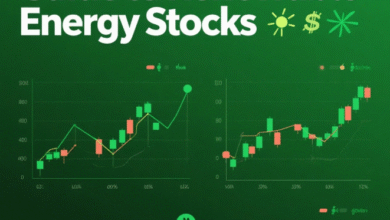Market Volatility Patterns: How to Identify, Analyze, and Profit in Unstable Markets
Advertisement
Every time I check the markets, I notice how quickly prices can swing from calm to chaotic. Market volatility isn’t just a buzzword—it’s the pulse that keeps traders and investors on their toes. Understanding these unpredictable shifts is crucial for making informed financial decisions and staying ahead of the curve.
I’ve seen how certain patterns tend to repeat themselves even when the reasons behind the moves seem new. By spotting these volatility patterns, I can better anticipate risks and opportunities. Whether you’re a seasoned trader or just curious about the market’s mood swings, learning about volatility patterns can give you a real edge.
Understanding Market Volatility Patterns
Market volatility patterns reveal recurring shifts in asset prices. These patterns often emerge during significant events, such as earnings releases, interest rate changes, or geopolitical developments. Recognizing repeating cycles, such as sudden price jumps following unexpected news or prolonged periods of quietness after announcements, helps me anticipate market reactions.
Short-term volatility tends to surface more during market openings or closings, when trading volumes spike. Long-term patterns emerge over quarters or years, often linked to economic cycles or sector rotations. I analyze chart formations, including head-and-shoulder patterns, double tops, and V-shaped recoveries, to identify potential turning points driven by volatility.
To measure volatility, I utilize tools such as the VIX index for US equities or ATR (Average True Range) for individual stocks. These indicators quantify price fluctuations and signal shifts in market sentiment. High readings on these tools correspond with uncertain or rapidly changing environments, while low readings suggest stability.
Tracking these volatility patterns, I adjust my risk management strategies and timing of entry and exit. Patterns such as sharp reversals, sustained rallies, or consolidation phases provide actionable signals when I review price movements in conjunction with macroeconomic factors.
Key Factors Influencing Market Volatility

Several external and internal elements impact volatility patterns. I monitor each factor to understand shifts in price behavior and adjust my market strategies accordingly.
Economic Indicators
Economic indicators drive short-term and long-term market volatility. I focus on data points with historical influence, including nonfarm payrolls, Consumer Price Index (CPI), and Gross Domestic Product (GDP). Significant releases, such as a higher-than-expected inflation rate or sudden drops in employment, trigger abrupt price swings. I track the timing and consensus of these releases to anticipate when volatility spikes might occur.
Geopolitical Events
Geopolitical events create sharp and often unpredictable changes in volatility. I observe instances such as trade negotiations, military conflicts, and elections, which instantly alter market outlooks. Examples include Brexit referendum outcomes, US-China trade talks, and Middle East tensions—each sparking rapid fluctuations across equity, currency, and commodity markets. I analyze ongoing developments to track emerging volatility clusters tied to these situations.
Investor Sentiment
Investor sentiment directly influences volatility through changes in buying and selling intensity. I analyze sentiment using tools like the VIX index and sentiment surveys. Overbought markets or widespread fear create distinct patterns, often leading to extreme short-term volatility. I study media coverage, social media trends, and investor positioning to capture signals that reveal potential shifts in sentiment-driven volatility.
Common Types of Market Volatility Patterns
Market volatility patterns can be categorized into several distinct types, each with unique triggers and implications for price movements. I track these main categories to adjust my trading approach and manage risks effectively.
Cyclical Volatility
Cyclical volatility patterns recur over defined intervals, reflecting the phases of economic and business cycles. I often observe increased volatility during transitions between monetary expansion and contraction. Equity and commodity markets show these cycles—examples include heightened fluctuation before and after interest rate adjustments or during quarterly earnings seasons. By noting the historical cycles of indices like the S&P 500, I can anticipate potential surges or declines in price movement.
Episodic Volatility
Episodic volatility patterns emerge suddenly in response to unexpected events. Examples include political announcements, surprise regulatory changes, or abrupt geopolitical incidents. I have noted significant spikes in volatility during incidents such as Brexit votes or central bank emergencies. Short-lived but intense, these episodes can disrupt trends, forcing rapid strategy changes. Monitoring real-time news feeds enables me to respond quickly to these volatility surges.
Seasonal Volatility
Seasonal volatility patterns align with calendar events and established market cycles. I see pronounced volatility near quarter-end rebalancing, around tax deadlines, or during annual earnings releases. For example, energy markets exhibit higher volatility during the winter months due to fluctuations in demand. Retail stocks reflect increased activity during holiday seasons. By analyzing these time-based patterns, I prepare for short-term price fluctuations associated with recurring annual events.
Analyzing Volatility With Technical Tools
I use technical analysis tools to detect and interpret market volatility patterns. These tools help me quantify shifts in price behavior and support tactical decisions during unstable market periods.
Moving Averages
I monitor moving averages—such as the 50-day and 200-day simple moving averages—to smooth short-term price noise and highlight trends in volatility. Crossovers between these averages signal changes in momentum. For example, a rapid widening between short- and long-term averages often warns me of accelerating volatility and potential trend reversals, making it easier to anticipate significant price movements.
Volatility Indexes (VIX)
I track the Volatility Index (VIX), calculated by the Chicago Board Options Exchange, to gauge market sentiment and future volatility expectations. Higher VIX readings, typically above 30, signal heightened uncertainty. Example periods include major earnings seasons and sudden geopolitical developments. I adjust my risk controls when VIX levels approach these marks, as they coincide with historically volatile environments.
| Volatility Index | Volatility Level | Typical Triggers |
|---|---|---|
| VIX (CBOE) | >30 (High) | Earnings, geopolitical tensions |
| VIX (CBOE) | 15-20 (Normal) | Regular trading sessions |
Bollinger Bands
I apply Bollinger Bands—a set of upper and lower bands placed two standard deviations above and below a moving average—to visualize price volatility. Prices moving outside these bands, as seen during earnings surprises or economic data releases, flag overbought or oversold market conditions. I spot breakout or mean-reversion setups more reliably by tracking band expansions and contractions, allowing me to align position sizes with current volatility.
Implications for Investors and Traders
Understanding market volatility patterns impacts my portfolio management and trading tactics. Recognizing repeatable volatility waves, I time entries and exits more precisely, thereby limiting losses during unpredictable swings, such as those in earnings weeks or following policy rate decisions. Observing cyclical and episodic shifts, I diversify allocations by adjusting exposure to sectors that exhibit stable or turbulent patterns, such as during energy or tech earnings seasons.
Incorporating technical analysis, I interpret signals from moving averages and Bollinger Bands to manage position sizes and stop losses, especially when volatility spikes near macroeconomic releases. Using the VIX and ATR data, I calibrate leverage and assess risk, increasing cash reserves when indicators signal elevated uncertainty or tightening spreads, and reducing them when volatility dampens.
By analyzing market sentiment and liquidity flows, I avoid crowded trades that often precede sharp reversals. I also implement hedging strategies during periods of geopolitical or seasonal volatility, allocating to non-correlated assets such as gold or short-term bonds to cushion the impact of abrupt market movements.
Adjusting strategies according to volatility regimes, I capitalize on short-term momentum in high-volatility environments while favoring mean-reversion trades as price ranges compress. Remaining adaptive, I review volatility data daily, integrating macroeconomic news and earnings calendar catalysts to maintain discipline and optimize returns.
Conclusion
Navigating market volatility takes patience, adaptability, and a commitment to ongoing learning. My approach is always evolving as new patterns and tools emerge in the financial landscape. I find that staying curious and disciplined helps me spot opportunities even in the most unpredictable markets.
By embracing volatility rather than fearing it, I can make more informed decisions and protect my portfolio from unexpected swings. The key is to remain proactive, monitor relevant data, and adjust strategies as conditions change. This mindset keeps me resilient and ready for whatever the market brings.
Frequently Asked Questions
What is market volatility?
Market volatility refers to the rate at which asset prices fluctuate in financial markets. It highlights how quickly and unpredictably prices can fluctuate, affecting both risk and potential returns for traders and investors.
What factors commonly influence market volatility?
Key factors include economic indicators such as the Consumer Price Index (CPI) and Gross Domestic Product (GDP), as well as geopolitical events like elections or trade disputes, and investor sentiment. These elements can trigger rapid price changes and make markets less predictable.
How can traders identify market volatility patterns?
Traders can identify patterns by observing price movements during specific events, such as earnings releases or interest rate decisions, and by using technical tools like moving averages, the VIX index, and Bollinger Bands.
What are the main types of market volatility patterns?
Market volatility patterns can be cyclical (linked to economic cycles), episodic (triggered by sudden events), or seasonal (related to recurring times, like holidays or quarter-end adjustments).
Why is understanding volatility important for investors and traders?
Recognizing volatility patterns enables investors and traders to time entries and exits, limit losses, and adjust strategies based on market stability or instability, thereby potentially improving returns and managing risk more effectively.
What tools are useful for measuring market volatility?
Popular tools include the VIX index, which measures market expectations of volatility, and the Average True Range (ATR), which tracks historical price movement ranges. Bollinger Bands are also helpful for visualizing volatility.
How can investor sentiment affect market volatility?
Investor sentiment, often monitored through surveys and tools like the VIX, influences the intensity of buying and selling. Extreme sentiment can amplify price fluctuations, resulting in higher short-term volatility.
How should strategies change during periods of high volatility?
During periods of high volatility, traders may reduce their position sizes, use tighter stop-loss orders, diversify across sectors, and consider hedging to manage risk and avoid excessive losses.
What is the significance of mean reversion in volatile markets?
Mean reversion is the concept that prices tend to return to their average over time. In volatile markets, mean-reversion strategies can help traders capitalize on overextended price movements and enhance returns.
How often should traders review volatility data?
Traders should review volatility data and macroeconomic news daily to stay informed about changing conditions, adjust strategies promptly, and maintain discipline in dynamic markets.










